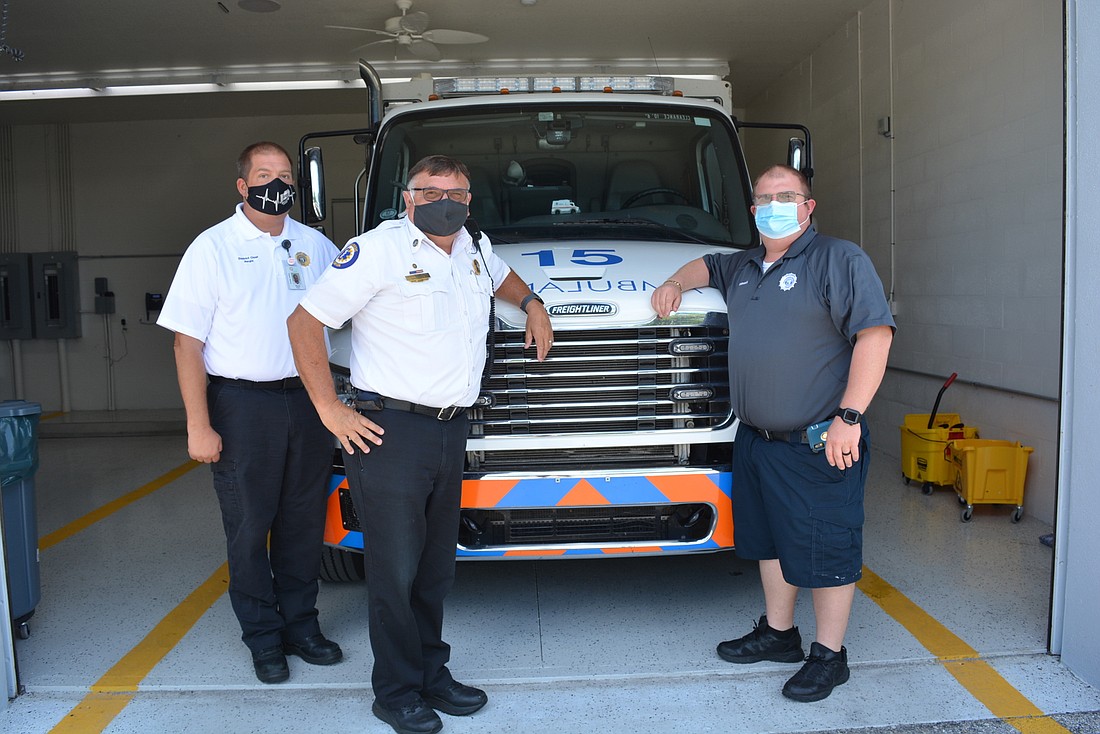- March 28, 2025
-
-
Loading

Loading

A year ago, Manatee County Emergency Medical Services had a problem.
Too often, an ambulance would arrive with a patient at one of Manatee County’s three hospitals — Blake Medical Center, Manatee Memorial Hospital or Lakewood Ranch Medical Center — and wait … and wait … and wait.
At times, ambulances would be backed up six deep to deliver patients. Other times, paramedics would have patients on stretchers “hugging the walls” inside the hospital as they waited for patients to be offloaded into the hospital’s care. It sometimes could take
up to two hours.
Other times, ambulances would be diverted to another hospital — or worse, diverted twice, said Larry Luh, assistant chief of operations for the Emergency Medical Services Division.
“That has drastically changed,” Luh said. “A lot of it has to do with communication and buy-in.”
Luh said that since October 2019, EMS has not any ambulances diverted from a local hospital because its emergency room was too busy.
EMS and hospital officials met monthly for the past year to work through the challenges, and hospitals have taken steps to adjust protocols, allowing for quicker processing of ambulance-transported patients.
Luh said EMS notifies hospitals when it is bringing patients to the emergency room, but it also tells them when EMS is experiencing a “surge” — when only six of 21 total ambulances are available to cover Manatee County’s 743 square miles. When that happens, EMS must strategically redistribute remaining ambulances to help ensure response times of nine minutes or less.
Hospitals have been processing patients more quickly to help minimize the number of surges.
“That’s helped our units get back into their zones,” Luh said. “It’s all about communication. We have not had a problem with diversion.”
Andy Guz, CEO of Lakewood Ranch Medical Center, said the hospital streamlined its process to reduce the “turnaround times” to get paramedics back on the road, responding to calls as quickly as possible. When EMS brings patients to a hospital, it must hand them off to a nurse or doctor and provide an account of why the patient is there and any actions or medications administered by EMS.
“We prioritize these EMS patients by trying to get a room ready for them before they arrive — EMS calls us ahead of time — and then we meet with them promptly once they arrive,” Guz said. “The goal is to get the EMS out the door within 15 minutes, but we are averaging under 10 minutes almost every day.”
Manatee Memorial Healthcare System CEO Kevin DiLallo said he is happy the collaboration with EMS is working well at his facility. As at Lakewood Ranch Medical, Manatee Memorial Hospital prepares to receive patients by preplanning available space and utilizing its nurses to assist with off-loading and taking reports from patients.
“This allows Manatee County EMS to get back into the community promptly and quickly to continue to serve patients,” DiLallo said. “It has been a good working relationship that best serves our community.”
Luh said such efforts have made a big difference for EMS operations.
He said there have been only 83 surges in the past eight months, compared with 163 for the prior eight months. Hours of surge dropped from 117 to 82 hours.
Jimmy Crutchfield, chief of Manatee County EMS, noted those numbers might be skewed somewhat due to the COVID-19 outbreak. Call volumes from March to May were between 68 to 91 daily, compared to the typical 120 to 180 calls. Numbers are now back to 120 or more calls daily, he said, but changes at hospitals seem to be working well still.
Helping with overall response time for EMS is the new 6,539-square-foot station at 10311 Malachite, which opened in May. It has been used both as a station and a training center for EMS’ needs.
The ambulance housed there previously was housed at East Manatee Fire Rescue District’s Station 6. Luh said paramedics enjoy having their own space to call “home” and also are enjoying the facilities new training center.
“It allows us our staff to have another location in the county to hold training sessions,” Luh said. “It keeps those staff members out east where we know the growth is happening.”